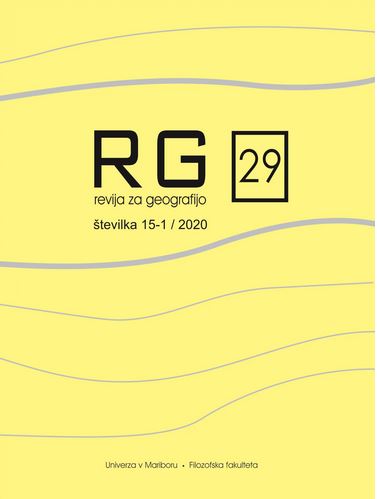Regional identity of young people in the Pomurje statistical region
DOI:
https://doi.org/10.18690/rg.15.1.3623Keywords:
Young people, spatial identity, regional identity, Pomurje statistical regionAbstract
Spatial identity can exist on different levels - local, regional and global level. If we focus to the level of the region, we are talking about regional identity. In Slovenia, some surveys of regional identity have been made, joined by the present, carried out on a sample of young people living in the Pomurje statistical region. With the survey method we found that young people living in the Pomurje statistical region do not primarily identify themselves as Pomurians. Young people with permanent residence in the Pomurje region also show different levels of regional identity in different identity indicators. At the same time, they evaluate the region more positively and rate its potentials higher than the surveyed young people living outside the region.
Downloads
References
Bernardo, F. in Palma-Oliveira, J., 2012: Place Identity: A Central Concept in Understanding Intergroup Relationships in the Urban Context. V Casakin, H. (ur.), The Role of Place Identity in the Perception, Understanding, and Design of the Built Environment (str. 35–46). Sharjah: Bentham Science Publishers.
Flegar, Š., 2020: Regionalna identiteta mladih v pomurski statistični regiji (Magistrska naloga). Univerza v Ljubljani, Filozofska fakulteta, Maribor.
Gostota naseljenosti in indeks feminitete, statistične regije, Slovenija, polletno. (b.d.). Pridobljeno s
https://pxweb.stat.si/SiStatDb/pxweb/sl/10_Dem_soc/10_Dem_soc__05_prebivalstvo__10_stevilo_preb__10_05C20_prebivalstvo_stat_regije/05C2010S.px/ (12. 12. 2019).
Karta slovenskih narečij z večjimi naselji, 2016: Pridobljeno s https://fran.si/204/sla-slovenski-lingvisticni-atlas/datoteke/SLA_Karta- narecij.pdf (30. 12. 2019).
Keating, M., 1998: Pridobljeno s https://doi.org/10.1177/096977649800500311 (30.3.2020).
Kosi, D., 2012 Identitetne regije Slovenije (Doktorska disertacija, Filozofska fakulteta Univerze v Mariboru). Pridobljeno s https://dk.um.si/Dokument.php?id=33940 (13. 1. 2020).
Kosi, D., 2013a: Prostorska identiteta v Sloveniji. Revija za geografijo – Journal for Geography, 8(2), 95–106. Pridobljeno s http://www.dlib.si/stream/URN:NBN:SI:doc-JLLS6NGD/78f2a120-38ad-40b0- 8dcb-440e464e72ed/PDF (28. 3. 2020).
Kosi, D., 2013b: Regionalna identiteta v Sloveniji. Dela, 39, 107–124. Pridobljeno s https://www.dlib.si/stream/URN:NBN:SI:DOC-YESU0NO5/5e293ac4-009f-4505- b4b2-18f244d975dd/PDF (29. 3. 2020).
Lewicka, M., 2008: Place attachment, place identity, and place memory: Restoring the forgotten city past. Journal of Environmental Psychology, 28, 209–231. Pridobljeno s http://citeseerx.ist.psu.edu/viewdoc/download?doi=10.1.1.485.8877&rep=rep1& type=pdf (30. 3. 2020).
Stare, M., 2015: Mladi v Sloveniji na splošno zadovoljni s svojim življenjem. Pridobljeno s https://www.stat.si/StatWeb/News/Index/5345 (10. 12. 2019).
Olaj, A., Gabrijelčič, P. in Fikfak, A., 2012: Urbani obvodni javni prostor – reka kot razvojni generator. Geodetski vestnik, 56(1), 151–168. Pridobljeno s http://www.geodetski-vestnik.com/56/1/gv56-1_151-168.pdf (30. 3. 2020).
Paasi, A., 1986: The institutionalization of regions: a theoretical framework for understanding the emergence of regions and the constitution of regional identity. Fennia, 164(1), 105–146. Pridobljeno s https://fennia.journal.fi/article/download/9052/19829 (24. 3. 2020).
Paasi, A., 2001: Bounded spaces in the mobile world: Deconstructing 'regional identity'. Tijdschrift voor conomische en Sociale Geografie, 93(2), 137–148.
Pomurska regija. (b.d.). Pridobljeno s https://www.stat.si/obcine/sl/2016/Region/Index/1 (17. 9. 2019).
Prebivalstvo po starosti in spolu, statistične regije, Slovenija, polletno. (b.d.). Pridobljeno s
(3. 12. 2019).
Prebivalstvo, staro 15 ali več let, po izobrazbi, petletnih starostnih skupinah in spolu, statistične regije, letno. (b.d.). Pridobljeno s https://pxweb.stat.si/SiStatDb/pxweb/sl/10_Dem_soc/10_Dem_soc__05_prebiv
alstvo__20_soc_ekon_preb__01_05G20_izobrazba/05G2010S.px/ (20. 5. 2020).
Prebivalstvo, staro 15 ali več let, po statusu aktivnosti, spolu in starosti, statistične regije, Slovenija, letno. (b.d.). Pridobljeno s https://pxweb.stat.si/SiStatDb/pxweb/sl/10_Dem_soc/10_Dem_soc__05_prebiv
alstvo__20_soc_ekon_preb__03_05G30_aktivnost/05G3011S.px/ (20. 5. 2020).
Prostorska identiteta. (b.d.). Pridobljeno s https://isjfr.zrc- sazu.si/sl/terminologisce/slovarji/urbanisticni/iskalnik?iztocnica=prost%C3%B3rs ka%20identit%C3%A9ta#v (23. 3. 2020).
Statistične regije Republike Slovenije, NUTS 3 (12). (b.d.). Pridobljeno s https://www.stat.si/dokument/5417/NUTS3_SURS_tisk.jpg (16. 12. 2019).
Qazimi, S., 2014: Sence of place and place identity. European Journal of Social Science Education and Research, 1(1), 306–310. Pridobljeno s http://journals.euser.org/files/articles/ejser_may_aug_14/ShukranQ.pdf
(28. 3. 2020).
Raagmaa, G., 2002: Regional Identity in Regional Development and Planning. European Planning Studies, 10(1), 55–76.
Urbanistični terminološki slovar, 2015: Pridobljeno s Terminologišče, elektronski iskalnik https://isjfr.zrc-
sazu.si/sl/terminologisce/slovarji/urbanisticni/iskalnik?iztocnica=prostorska%20i dentiteta#v)
(28. 3. 2020)
Downloads
Published
Issue
Section
License
Copyright (c) 2020 Špela Flegar

This work is licensed under a Creative Commons Attribution 4.0 International License.
